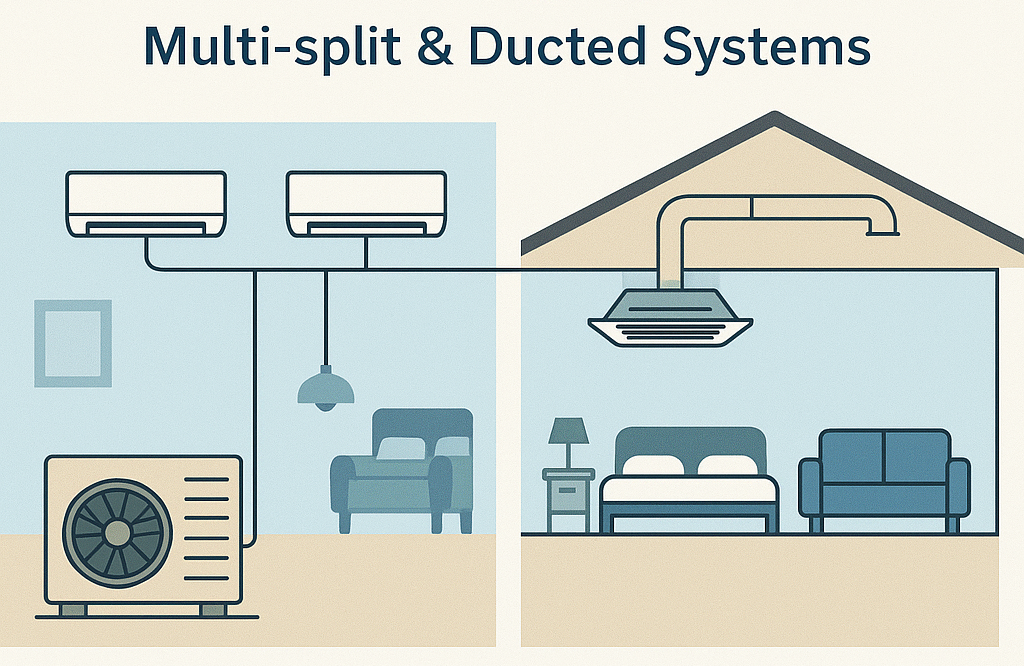Introduction to Air Conditioning Systems
Air conditioning systems have become an integral aspect of comfort in modern life, serving both residential and commercial spaces. The technology behind air conditioning dates back to the early 20th century, when the primary aim was to control humidity for industrial processes. Today, the application of air conditioning has expanded significantly, improving indoor air quality and enhancing comfort through effective temperature regulation.
In Australia, where climate conditions can vary dramatically from tropical in the north to temperate in the south, the need for efficient climate control has never been more essential. Extreme temperatures can affect productivity, health, and overall well-being; therefore, the appropriate selection of air conditioning systems can play a crucial role in creating comfortable living and working environments. Among the various types of air conditioning systems available, multisplit and ducted systems are particularly noteworthy for their efficiency and effectiveness.
A multisplit air conditioning system connects multiple indoor units to a single outdoor unit, allowing for individualized temperature control in different rooms. This makes it an ideal choice for homes and offices with varying heating and cooling needs. The versatility and energy-efficient nature of multisplit systems have contributed to their increasing popularity in urban areas where homes and apartments demand tailored solutions.
Ducted air conditioning, on the other hand, is designed to cool or heat multiple rooms through a series of ducts installed in the ceiling or under the floor. This type of system provides whole-home climate control and is often preferred in larger residential or commercial settings. Ducted systems can be discreetly installed, maintaining the aesthetic of the interior design while ensuring comprehensive temperature regulation across various spaces.
The understanding of these two systems, multisplit and ducted, is imperative as they each cater to distinct needs and preferences, making them vital components of Australia’s ever-evolving climate control strategies.
Multi-split Air Conditioning Systems
Multisplit air conditioning systems are advanced climate control solutions that consist of one outdoor unit connected to multiple indoor units. This design allows homeowners and businesses to efficiently manage heating and cooling in various spaces simultaneously. Leveraging a single outdoor compressor, multisplit systems facilitate a flexible and energy-efficient approach to air conditioning.
The primary components of a multisplit air conditioning system include:
- Outdoor unit: Houses the compressor and condenser, drawing in air for cooling.
- Indoor units: These can be wall-mounted, ceiling-mounted, or floor-standing units, providing versatile options for installation.
- Refrigerant lines: Connecting the outdoor unit to each of the indoor units, these lines transport refrigerant, which is essential for heat exchange.
- Controls: Individual thermostats or smart control systems allow for precise temperature regulation in different zones.
Common applications for multisplit air conditioning systems in Australian homes and businesses include residential properties with multiple rooms, offices with different workspace requirements, and commercial settings like restaurants and retail stores. The versatility of these systems makes them suitable for varying heating and cooling demands throughout the year.
Some distinct advantages of multisplit systems are:
- Energy efficiency: By conditioning only the occupied spaces, multisplit systems reduce energy consumption while maintaining comfort.
- Flexibility in installation: With multiple indoor units connected to a single outdoor unit, these systems offer more options for installation compared to traditional split systems.
- Ability to control multiple zones: Individual indoor units can be set to different temperatures, catering to the preferences of various occupants.
However, there are also some disadvantages to consider:
- Higher upfront costs: The initial investment for multisplit systems tends to be significant compared to single-split units.
- Maintenance challenges: With multiple indoor units, servicing and maintenance may become more complex, requiring specialized knowledge.
Overall, while multisplit air conditioning systems offer numerous benefits in terms of efficiency and comfort, potential users should weigh these advantages against the associated costs and maintenance requirements.

Ducted Air Conditioning Systems
Ducted air conditioning systems offer a centralized method of cooling and heating that is particularly effective in larger homes or commercial spaces. The system operates through a network of ducts that distribute conditioned air to various rooms or zones within a building. This is achieved by a central unit that cools or heats the air before it is blown into the ductwork, ensuring uniform temperature distribution across the premises.
The key components of a ducted air conditioning system include:
- Central Unit: This is the core of the system, responsible for cooling or heating the air.
- Ducts: Typically made from metal or flexible materials, ducts transport air from the central unit to different areas of a building.
- Vents: Located in each room, vents release the conditioned air and can be adjusted to control airflow.
In the Australian context, ducted air conditioning systems are especially advantageous due to the country’s diverse climate. These systems are ideal for larger homes or buildings where maintaining a consistent temperature throughout different areas is essential. They can seamlessly blend with the architectural design of a home, providing aesthetic appeal and minimal visual disruption.
Among the many advantages of ducted systems is their ability to distribute air evenly, addressing hot or cold spots that often occur with other cooling methods. Additionally, ducted systems can incorporate additional heating options, allowing for year-round comfort. However, there are notable disadvantages. The initial installation costs remain relatively high, and the space required for ductwork can be a limiting factor in smaller homes or retrofitting projects.
Overall, understanding the operation and components of ducted air conditioning systems is crucial for making an informed decision in selecting an effective climate control solution that meets your needs.
Comparative Advantages of Multisplit vs. Ducted Systems
When evaluating air conditioning systems, it is essential to understand the comparative advantages of multisplit and ducted systems. Both options cater to diverse consumer needs, with unique features that may appeal to different situations. Below, we present a comparative analysis to facilitate informed decisions.
| Feature | Multisplit Systems | Ducted Systems |
|---|---|---|
| Energy Efficiency | Generally high; energy-efficient models available | Can be energy-efficient; however, duct losses may occur |
| Cost | Lower upfront cost; installation varies by units | Higher initial investment; cost-effective for larger areas |
| Ease of Installation | Simpler installation process; minimal ductwork required | Complex installation; requires extensive ductwork |
| Control Options | Individual control for each indoor unit | Centralized control offers uniform temperature regulation |
Suitability Scenarios
- Multisplit Systems: Ideal for smaller homes or apartments needing cooling in specific areas, where installation simplicity and lower cost are a priority.
- Ducted Systems: Suitable for larger properties where consistent temperature throughout multiple rooms is desired, providing a more seamless aesthetic with hidden ducts.
Expert recommendations suggest considering the Australian climate when choosing between the two systems. Regions experiencing extreme temperatures may benefit from ducted systems for their ability to distribute cool air evenly. Conversely, for climate zones with mild conditions, multisplit systems could be sufficient and cost-effective.
When selecting the appropriate air conditioning system, consider individual heating and cooling needs, budget constraints, and layout of the living space. Assess the specific benefits of each system type concerning energy efficiency, installation complexity, and intended use to make the best choice for your home.


Hi, this is a comment.
To get started with moderating, editing, and deleting comments, please visit the Comments screen in the dashboard.
Commenter avatars come from Gravatar.